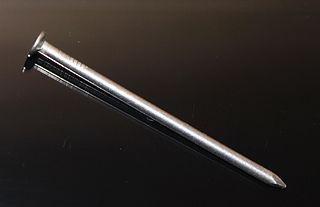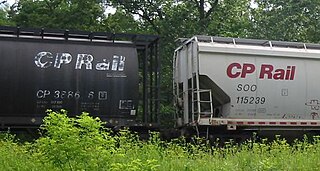
In woodworking and construction, a nail is a small object made of metal which is used as a fastener, as a peg to hang something, or sometimes as a decoration. Generally, nails have a sharp point on one end and a flattened head on the other, but headless nails are available. Nails are made in a great variety of forms for specialized purposes. The most common is a wire nail. Other types of nails include pins, tacks, brads, spikes, and cleats.

A railroad tie, crosstie, railway tie or railway sleeper is a rectangular support for the rails in railroad tracks. Generally laid perpendicular to the rails, ties transfer loads to the track ballast and subgrade, hold the rails upright and keep them spaced to the correct gauge.

Wigwag is the nickname given to a type of railroad grade crossing signal once common in North America, named for the pendulum-like motion it used to signal the approach of a train. It is generally credited to Albert Hunt, a mechanical engineer at Southern California's Pacific Electric (PE) interurban streetcar railroad, who invented it in 1909 for safer railroad grade crossings. The term should not be confused with its usage in Britain, where wigwag is generally used to refer to alternate flashing lights, such as those found at modern level crossings.

In computing, a memory address is a reference to a specific memory location used at various levels by software and hardware. Memory addresses are fixed-length sequences of digits conventionally displayed and manipulated as unsigned integers. Such numerical semantic bases itself upon features of CPU, as well upon use of the memory like an array endorsed by various programming languages.

A reporting mark is a code used to identify owners or lessees of rolling stock and other equipment used on certain rail transport networks. The code typically reflects the name or identifying number of the owner, lessee, or operator of the equipment.
A number of different numbering and classification schemes were used for locomotives and multiple units operated by British Railways (BR), and this page explains the principal systems. This section also covers the post-privatisation period, as the broad numbering and classification arrangements have not altered since the break-up of BR.

ISO 6346 is an international standard covering the coding, identification and marking of intermodal (shipping) containers used within containerized intermodal freight transport. The standard establishes a visual identification system for every container that includes a unique serial number, the owner, a country code, a size, type and equipment category as well as any operational marks. The standard is managed by the International Container Bureau (BIC).

A utility pole is a column or post used to support overhead power lines and various other public utilities, such as electrical cable, fiber optic cable, and related equipment such as transformers and street lights. It can be referred to as a transmission pole, telephone pole, telecommunication pole, power pole, hydro pole, telegraph pole, or telegraph post, depending on its application. A Stobie pole is a multi-purpose pole made of two steel joists held apart by a slab of concrete in the middle, generally found in South Australia.
In computer science, data validation is the process of ensuring data has undergone data cleansing to ensure they have, that is, that they are both correct and useful. It uses routines, often called "validation rules", "validation constraints", or "check routines", that check for correctness, meaningfulness, and security of data that are input to the system. The rules may be implemented through the automated facilities of a data dictionary, or by the inclusion of explicit application program validation logic of the computer and its application.

Automotive tires are described by an alphanumeric tire code or tyre code, which is generally molded into the sidewall of the tire. This code specifies the dimensions of the tire, and some of its key limitations, such as load-bearing ability, and maximum speed. Sometimes the inner sidewall contains information not included on the outer sidewall, and vice versa.

In South Korea, the Surface Transportation Bureau of the Ministry of Land, Infrastructure and Transport (MOCT) oversees the design and issue of license plates for motor vehicles. The international code for South Korea is ROK.

A button cell, watch battery, or coin battery is a small single cell battery shaped as a squat cylinder typically 5 to 25 mm in diameter and 1 to 6 mm high — resembling a button. Stainless steel usually forms the bottom body and positive terminal of the cell. An insulated top cap is the negative terminal.

The National Location Code (NLC) is a four-digit number allocated to every railway station and ticket issuing point in Great Britain for use with the ticketing system on the British railway network. They are used in the issue of tickets and for accounting purposes. They are a subset of the NLCs created by British Rail, which are based on four "main" digits plus two supplementary digits.

Tail codes are markings usually on the vertical stabilizer of U.S. military aircraft that help identify the aircraft's unit and/or base assignment. This is not the same as the serial number, bureau number, or aircraft registration which provide unique aircraft identification.
The UIC identification marking for tractive stock is a standard for identifying train stock like locomotives that supply tractive force. Since the beginning of 2007 locomotives or other traction units in Europe have been given a 12-digit number. Vehicle numbering is now governed by the Intergovernmental Organisation for International Carriage by Rail and in Technical Specifications for Interoperability (TSI) of the European Union, specifically the European Railway Agency's CR OPE TSI. This makes the locomotive clearly identifiable within Europe and parts of Asia and northern Africa.

Wagon numbers are key data for railway operations. They enable a railway wagon or coach to be positively identified and form a common language between railway operators, infrastructure companies and the state authorities. The system of wagon numbering has been laid down by the International Union of Railways and is similar to that used for the locomotives and multiple units. Vehicle numbering is now governed by the Intergovernmental Organisation for International Carriage by Rail and in Technical Specifications for Interoperability (TSI) of the European Union.

A rail fastening system is a means of fixing rails to railroad ties or sleepers. The terms rail anchors, tie plates, chairs and track fasteners are used to refer to parts or all of a rail fastening system. Various types of fastening have been used over the years.
Standard battery nomenclature describes portable dry cell batteries that have physical dimensions and electrical characteristics interchangeable between manufacturers. The long history of disposable dry cells means that many different manufacturer-specific and national standards were used to designate sizes, long before international standards were reached. Technical standards for battery sizes and types are set by standards organizations such as International Electrotechnical Commission (IEC) and American National Standards Institute (ANSI). Popular sizes are still referred to by old standard or manufacturer designations, and some non-systematic designations have been included in current international standards due to wide use.
Aerial roof markings are symbols, letters or numbers on the roof of selected police vehicles, fire engines, ambulances, coast guard vehicles, cash-in-transit vans, buses and boats to enable aircraft or CCTV to identify them. These markings can be used to identify a specific vehicle, vehicle type or agency. The markings, depending on the vehicle, or information required, may also be displayed on the bonnet, boot, or other areas of the vehicle visible from the air.

KarTrak, sometimes KarTrak ACI is a colored barcode system designed to automatically identify railcars and other rolling stock. KarTrak was made a requirement in North America, but technical problems led to the abandonment of the system in the late 1970s.

















